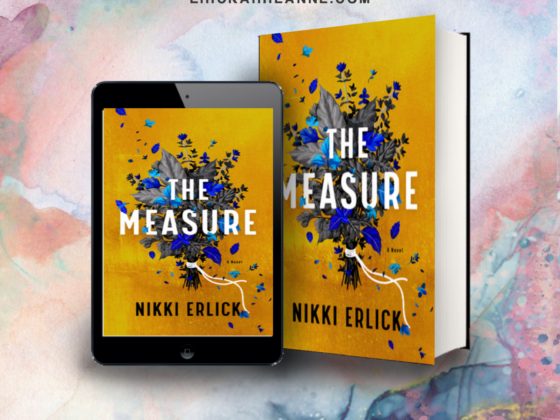This review contains affiliate links. That means I receive a small commission to no cost to you from any purchases you make through these links
Lessons in Chemistry by Bonnie Garmus
- Publisher: Doubleday Books < Penguin Random House
- Genre: Fiction < Literary Fiction
- Audience: Adult
- Pages: 400 (hardcover)
Chemist Elizabeth Zott is not your average woman. In fact, Elizabeth Zott would be the first to point out that there is no such thing as an average woman. But it’s the early 1960s and her all-male team at Hastings Research Institute takes a very unscientific view of equality. Except for one: Calvin Evans; the lonely, brilliant, Nobel–prize nominated grudge-holder who falls in love with—of all things—her mind. True chemistry results. But like science, life is unpredictable. Which is why a few years later Elizabeth Zott finds herself not only a single mother, but the reluctant star of America’s most beloved cooking show Supper at Six. Elizabeth’s unusual approach to cooking (“combine one tablespoon acetic acid with a pinch of sodium chloride”) proves revolutionary. But as her following grows, not everyone is happy. Because as it turns out, Elizabeth Zott isn’t just teaching women to cook. She’s daring them to change the status quo.
“Courage is the root of change—and change is what we’re chemically designed to do.“
lessons in chemistry
Admittedly, I went into Lessons in Chemistry not expecting a whole lot.
I’m not entirely sure why I went into the novel expecting to dislike it. Perhaps it was the way the synopsis did nothing to capture my interest. Perhaps it was the historical aspect of it; spoiler, I am not a fan of historical fiction. Perhaps it was the aspect of the chemistry based cooking show–science was my worst subject in school, and I am a notoriously bad cook (for proof, I have a six inch burn scar up my wrist from an unfortunate accident involving a microwavable snack).
Nevertheless, Bonnie Garmus managed to not only exceed my low expectations, but absolutely shock me to my core.
In all honesty, I’m not typically a huge fan of in-your-face, obvious social commentary in the novels I read.
So the first 35% or so of the novel, I found myself often annoyed with and fed up by the constant emphasis on rampant sexism and Zott’s feminism. It was overwhelming, didactic, and almost melodramatic in the way Garmus wrote Zott’s innovative ways of thinking, and her progressive opinions she wasn’t afraid to voice. It was because of this that I hypothesized this novel would get a three star rating from me. Pretty good, but nothing great.
It was this didactic feminist viewpoint, and the extreme amount of emphasis on it that made me question the world-building.
Of course, I’m not much of a history buff, and I have no clue, really, what the social climate was for women in the 1950s-60s. But throughout this book, I often found myself in a state of disbelief. Surely, this was being dramatic? Surely, not every single man and so many women were this sexist, this misogynistic, this unprogressive at this period? It seemed a bit unrealistic for me.
I’m in no way implying that sexism and misogyny weren’t a thing back then, especially in the STEM fields. I’m not even saying it wasn’t a huge issue. Because it definitely was, and though it might of lessened in the past half-century, they’re still issues we women face today. However, I stand by the fact that I believe that Garmus was a bit hyperbolic with her portrayal of these social aspects of Zott’s life within this time frame.
It seemed as though every person we met in the first half of the book, aside from Zott herself, exemplified sexist or misogynistic behaviors or thoughts. Even Calvin himself, though he eventually apologized to Zott for the manner of behavior he displayed when they first met.
However, all that being said… after the 60% mark, though Zott was feminist and vocal about it as ever, and even more instances of sexism and misogynistic drama kept piling up, I found myself more entertained and connected to the different storylines and characters than I thought I would be.
The cast of characters introduced in Lessons in Chemistry are top teir, from our main character, Elizabeth Zott, down to even the brilliant family dog, Six-Thirty.
If there’s one thing I now know Garmus has a phenomenal talent for, it’s taking a huge cast of characters and absolutely thriving with it. We’ve got the villainous characters: the sexual predators, the nightmare of a tv producer, the bully of a teacher, the poor excuses for bosses in the STEM field. We’ve also got the gems: Elizabeth Zott herself, her bright daughter, the personified dog Six-Thirty, the charming Calvin Evans, the sympathetic and motherly neighbor Harriet, etc.
There are too many characters to list, and yet, somehow they all managed to make an impression within 400 pages. Not only did they all make significant impressions, but each character had their own distinct stories, with distinguishable characteristics that set them apart from another, and an actual hand in the events that unfolded within the plot.
It was because of the characters, and of course the brilliance of Garmus’ writing style (which I will get to in a moment) that caused Lessons in Chemistry to sneak up on me. It wasn’t long before I found myself utterly captured and drawn inexplicably into this story, these characters, and their fates.
With Lessons in Chemistry, what you see is what you get.
There is not much within the novel that can’t be gained from the synopsis. Sure, it’s missing the fine details, and there is a few mysteries and hidden agendas within Elizabeth’s and Calvin’s past, and with their former employers at Hastings Research Institute, but for the most part, you get exactly what the synopsis promises.
So, if there is little in the way of shocking revelations or unrevealed plot points, what exactly keeps the reader engaged with Lessons in Chemistry?
Well, aside from the phenomenal cast of characters, it’s Bonnie Garmus’ writing style that deserves the recognition most of all. Her prose is beautiful and Elizabeth’s character is strange and detached but at the same time compassionate and passionate about the things and people she cares for most.
The most unique factor of Garmus’ writing, though is the omniscient third person she tends to use throughout. At first, it might take some getting used to, as Garmus likes to employ this strategy at random intervals, within the same scenes, sometimes the same paragraph. For example, in scenes with Elizabeth Zott and her neighbor Harriet, most of the scene will be in Zott’s point of view (most of the novel is), but suddenly might switch to Harriet’s thoughts or her backstory, then back to Zott’s POV in a few sentences as if the switch had never happened.
This doesn’t disrupt the story, and the way these POVs are woven together, in the same scene, while events are unfolding, is done seamlessly. Though it does mean readers have to pay attention and be super attentive to what they’re reading (skim readers, this isn’t for you)!
Lessons in Chemistry astounded me in every regard. Not only is this a beautifully written debut by Garmus, but its honor as Barnes & Noble’s book of the year is incredibly well-deserved and hard-earned.
TROPES AND TRIGGER WARNINGS FEATURED
- Sexual assault
- Sexism
- Cooking show
- Women in STEM
- Multiple POVs, Omniscient
OFFICIAL rating
Lessons in Chemistry
Lessons in Chemistrysimilar titles to Lessons in Chemistry



click on the covers above to learn more

Let’s Chat in the Comments!
Lessons in Chemistry was awarded B&N’s book of the year! What did you think about the novel, and do you think it deserves this praise? So many novels about women in STEM have been coming out lately, is this a sub-genre you’ve taken a liking to? If so, what are some of your favorite women-in-stem books?









